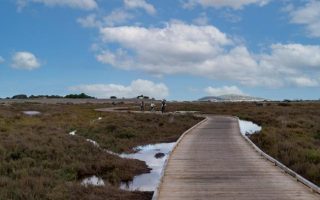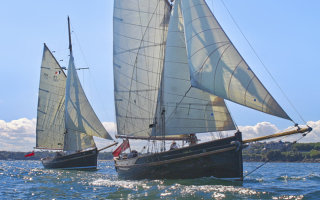Through the Grapevine: Vinothérapie

It’s called vinothérapie, and it’s a combination of water-based balnéothérapie, massage, whirlpool baths, wraps, exfoliations and more. The difference is that all these treatments use products made from grapes. Invigorating, revitalizing, as appealing to men as to women. No cell phones, clocks or stress, just warm herbal teas and grape juice. It’s the French Paradox, applied to the spa.
The idea developed out of a few happy coincidences. Some 20 years ago, Florence and Daniel Cathiard bought the Château Smith Haut Lafitte, in the Bordeaux region of Pessac Léognan, and they were determined to make the domaine one of the best. The couple has two daughters and the older daughter, Mathilde, was a business student who wanted to work in the perfume industry, which fascinated her. In 1993, in a conversation with Professor Joseph Vercauteren of Bordeaux University’s school of pharmacy, she learned that grape peel and seeds, discarded after the grapes are pressed for wine, contained polyphenols, powerful antioxidants that are effective in the fight against free radicals, the main cause of skin aging.
Intrigued by the discovery, she realized that her family could derive additional benefits from the vineyard if they could discover a way to isolate the correct molecule and stabilize it. For two years a team of scientists headed by Vercauteren worked on the project, eventually developing their now-patented process. The Caudalie company was launched in 1994 with three products and a standard that is still in effect today: no artificial coloring, no ingredients of animal origin and affordable prices. At about the same time, Florence Cathiard wanted to create some guest rooms on the property, and Mathilde asked her mother to add a few rooms where Caudalie products could be used in spa treatments. While workers were excavating the selected site, they discovered a hot spring. It was too good an opportunity to pass up—the guest room idea grew into Les Sources de Caudalie, a hotel and spa complex in the middle of the vineyard. Vinotherapy was born.
Ponds and peacocks
Les Sources de Caudalie recently celebrated its tenth anniversary by obtaining France’s new five-star hotel rating and hiring an extremely talented new chef, Nicolas Masse. But it remains a family affair: Mathilde’s younger sister Alice and her husband Jérôme Tourbier manage the place with efficiency and panache. New clients are constantly being added to the roster of faithful regulars, because a stay here is a vacation to the tenth power, and once you’ve tried it, it’s hard to stay away.
Although modern, the rustic-style buildings blend perfectly into the landscape. Architect Yves Collet has created an ensemble that’s not only comfortable and functional, but also charming and beautiful—49 rooms and suites, all different, in a handful of buildings surrounded by vineyards, with swans afloat on a pond and peacocks wandering freely. The main building, La Bastide des Grands Crus, is modeled on a ferme-bastide of the Bordeaux region; La Maison du Lièvre is a typical house of the Landes region to the south; La Grange au Bateau—the boat barn—evokes the ocean just a few miles away; La Table du Lavoir, the bistrot, is patterned after ancient wash sheds; and the gastronomic restaurant, La Grand’Vigne, was inspired by 18th-century greenhouses.
The Ile aux Oiseaux is a private suite in a cabane tchanquée—a wooden cabin on pilings, typical of the Gironde and the nearby Bay of Arcachon. Perched over a small pond, separate from the rest of the hotel, it’s just been redecorated by the Maison Martin Margiela in honor of the tenth anniversary. White and off-white throughout, its one spot of vivid color is a “Bocca” sofa shaped like an immense pair of red lips. The walls are completely covered in life-sized black-and-white photos of ornamental moldings from a 19th-century apartment—the effect is both astonishing and poetic. The floor is covered with white cowhide, and instead of a headboard the bed has a dozen pillows piled up to the ceiling. The bathroom is in keeping with the rest, with antique mirrors and a PVC floor that is a photograph of ancient tiles. It all adds up to an atmosphere both dream-like and joyful.
Barrel bath
The spa building, contemporary in style but reminiscent of a traditional tobacco-drying barn, complements the others, adding to the overall impression of a rural hamlet like so many that can be seen scattered throughout Aquitaine. The luxurious interior is mostly stone and wood, and the light is filtered by panels that can be angled so clients can enjoy the view without being seen from the outside.
As for the spa menu, the trained personnel are adept at prescribing appropriate treatments, and no matter what the choice, clients usually leave delighted. The salle de repos and the pool provide relaxing pauses between treatments, and in good weather there are open-air terraces for sunbathing. As for the now-famous “barrel bath” in red wine or grape marc, accompanied by a scalp massage, it’s the indispensable preliminary to a gommage (exfoliation) with crushed cabernet sauvignon grapes, a wine and honey wrap or a massage with fresh grape pulp.
Bordeaux residents often come out to Les Sources just for a meal, especially now that Nicolas Masse presides over both the restaurant and the bistrot. Masse also offers cooking classes, and chief sommelier Aurélien Farrouil gives wine-tasting courses. To accompany meals, there’s a selection of wines by the glass that includes all 24 Graves crus classés.
Nearer to Paris
Spa lovers who can’t make it to the Bordeaux region now have a second vinotherapy option. Jérôme and Alice Tourbier recently created a second spa, buying and completely renovating a famous old hotel in Ville d’Avray, less than an hour from Paris (see our May 2009 issue). Les Etangs de Corot, named for the local étangs, or ponds, that 19th-century artist Jean-Baptiste Corot portrayed in his romantic landscapes, was once the haunt of many artists. In the early 1900s, le tout Paris flocked to this rural guinguette-auberge for all-day frolics in the countryside. It’s still an officially classified historical site, but now it’s also a fabulous hotel-restaurant just as beautifully designed and comfortable as the original Sources de Caudalie. All 43 rooms and suites are individually decorated, and two restaurants offer the top-quality cuisine of Benoît Bordier, an inventive and provocative young chef.
It’s a great getaway destination for exhausted city dwellers and weary travelers alike. A cocoon of luxe, calme et volupté, the Caudalie spa here offers the same treatments as the Bordeaux original, and the staff is just as amiable and attentive. For visitors, it’s a wonderful way to relax and be pampered, whether for a day, a weekend or a week, combining the dynamic attractions of the City of Light with the bucolic charm of the countryside.
NOTEBOOK
Caudalie is an obscure wine-tasting term, a measure of time equivalent to a second, counted after one has swallowed the wine, used to describe how long the taste lingers on the palate. Theoretically, the more numerous the caudalies, the better the wine. But the word is seldom used because precise measurement of longueur en bouche is so difficult.
Les Sources de Caudalie Chemin du Smith Haut Lafitte, Bordeaux-Martillac. 05.57.83.83.83. website
Les Etangs de Corot 55 rue de Versailles, Ville d’Avray. 01.41.15.37.00. website
Originally published in the February 2010 issue of France Today.
Share to: Facebook Twitter LinkedIn Email



